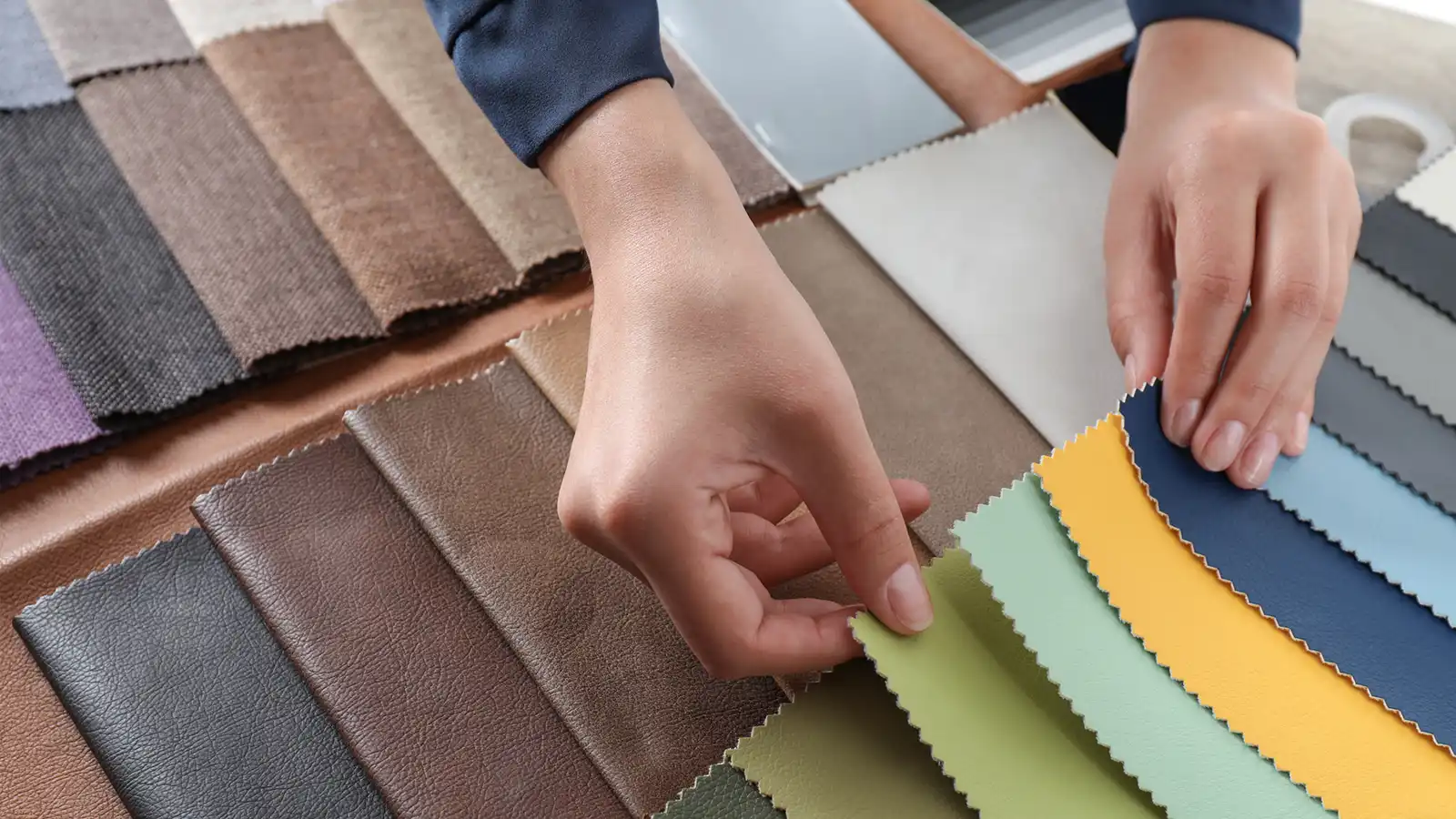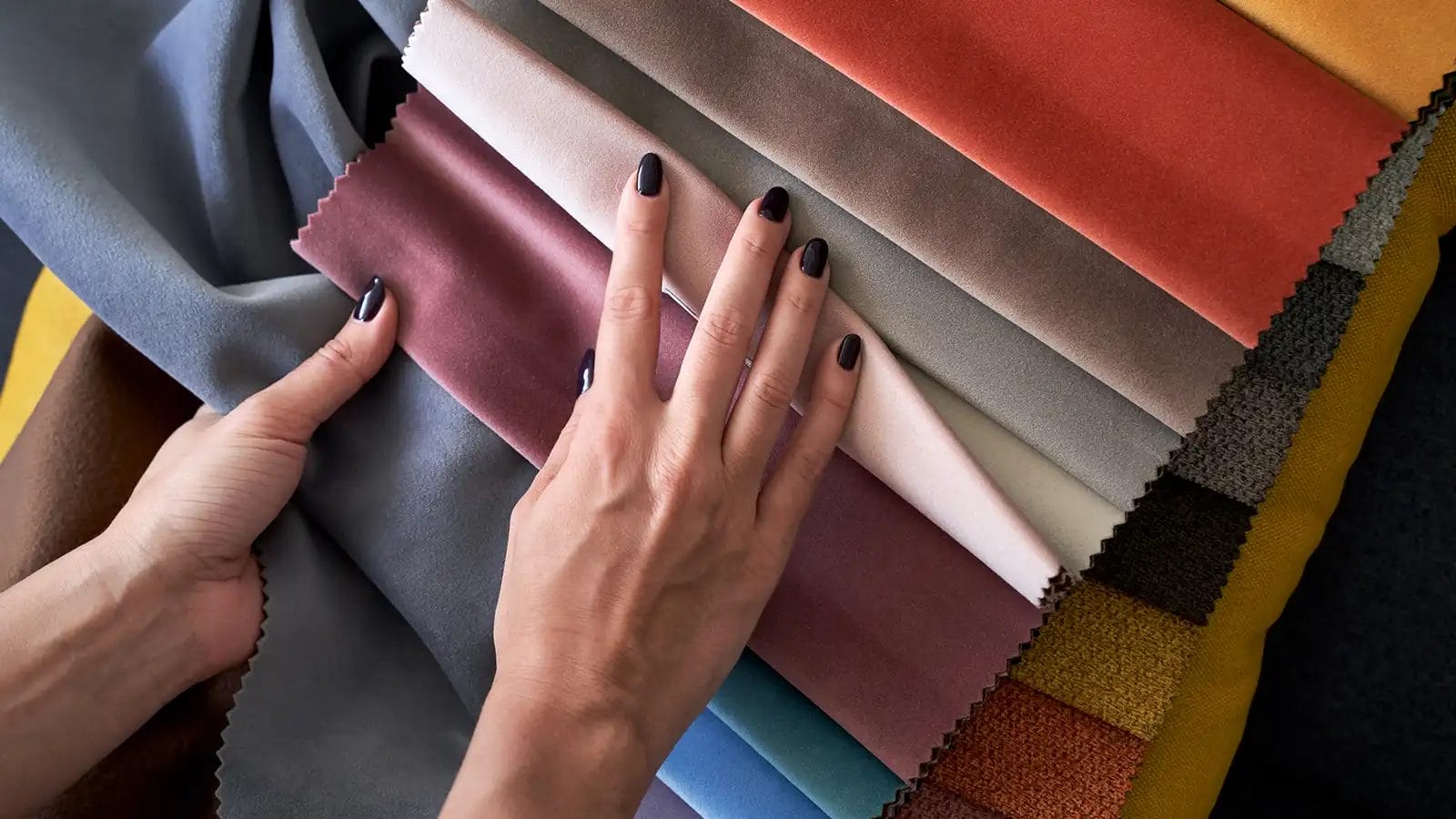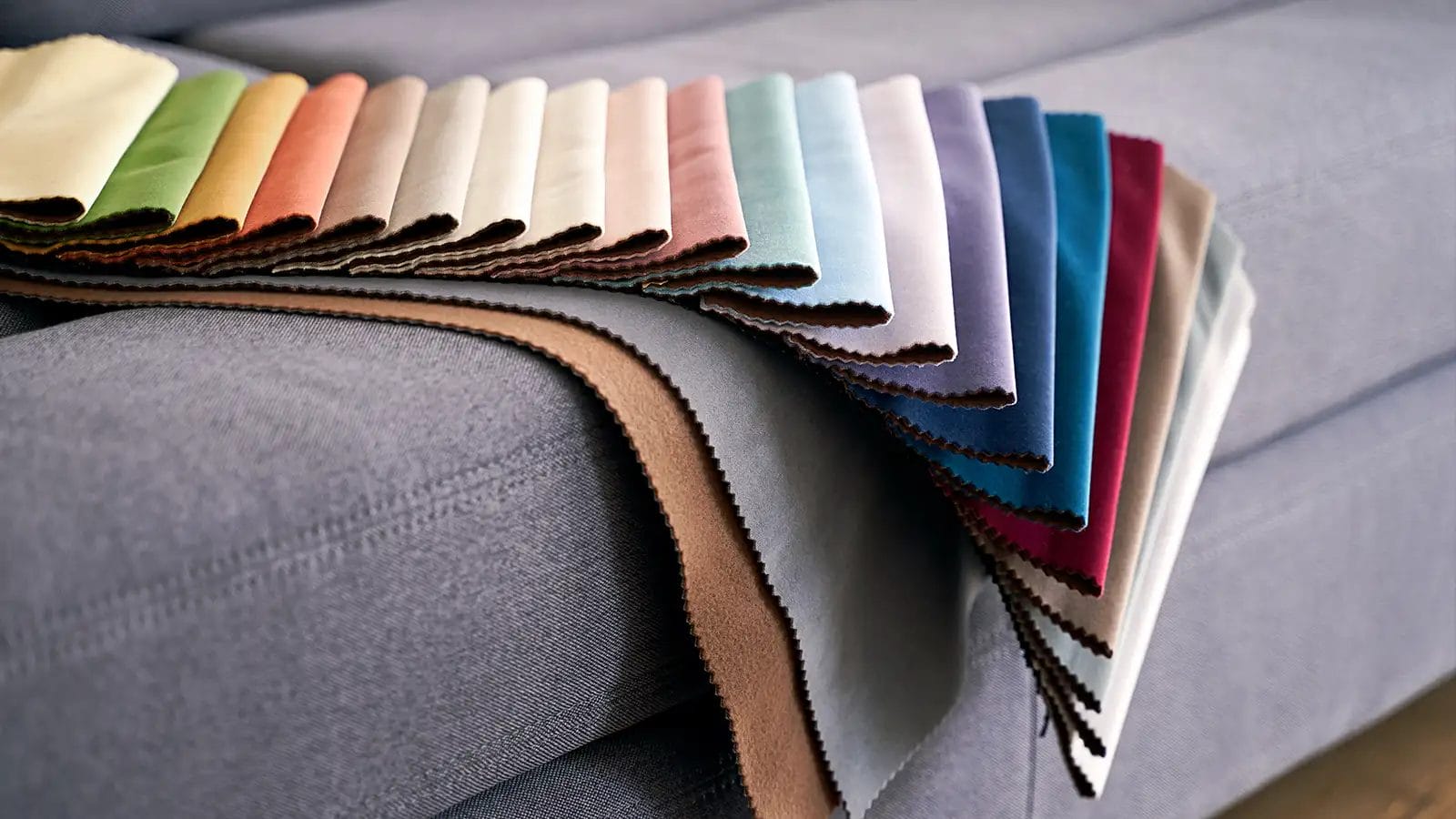Choosing the right upholstery fabric is essential for your home's style and function. There are countless options available. So, it can be overwhelming to decide on the perfect material.
This guide will help you navigate various fabric types, colors, and patterns. It'll ensure you choose to enhance your whole room and meet your lifestyle needs. Whether you tend to functions or aesthetics, we’ll cover all the essential factors!
Key Takeaways
- Consider lifestyle compatibility, opting for pet- and child-friendly fabrics if necessary.
- Ensure durability by selecting high double-rub count fabrics for high-use areas.
- Focus on stain-resistant and easy-to-clean materials for maintenance convenience.
- Match fabric colors and patterns with your room's aesthetic and lighting.
- Factor in budget constraints, recognize hidden costs, and use sales for quality fabrics.
Types of Fabric in Upholstery

When choosing upholstery textiles, you'll encounter various types. Each type has its unique benefits.
Natural Fabrics
Natural fabrics offer a diverse range of choices for upholstery. Each brings unique benefits to the table.
- Cotton: Soft and breathable but may wrinkle easily.
- Linen: Crisp and elegant but prone to wrinkling.
- Wool: Durable, naturally resists dirt and fading.
- Silk: Luxurious but delicate; best for low-use areas.
- Hemp: Eco-friendly, strong, and mold-resistant.
- Jute: Rustic and biodegradable; coarse texture.
Synthetic Fabrics
Synthetic upholstery fabrics are a practical and durable choice for sofas and chairs. They're also known for stain resistance and endurance. These features make them ideal for high-traffic areas.
- Polyester: Strong, wrinkle-resistant, and easy to clean.
- Nylon: Durable, abrasion-resistant, and pest-resistant.
- Acrylic: Soft, wool-like, with vibrant colors.
- Olefin: Stain-resistant and great for outdoor use.
- Rayon: Often blended for added strength.
- Vinyl: Easy to clean and waterproof, ideal for commercial use.
Leather and Faux Leather
Leather and faux leather are popular for upholstered items. This is because of their resilience and aesthetic versatility.
Genuine leather offers unmatched longevity and a unique patina. But it demands regular maintenance and comes at a higher cost.
Faux leather provides an affordable, easy-to-clean alternative with diverse styles. But its synthetic nature raises environmental concerns.
Blended Fabrics
For upholstery, choosing blended fabrics can offer the best of both worlds.
- Polyester-Cotton: Offers a soft and breathable feel with added strength.
- Polyester-Acrylic: Known for sturdiness and vibrant colors.
- Wool-Polyester: Combines warmth and softness with easy maintenance.
- Linen-Cotton: Provides a natural look with comfort and flexibility.
- Nylon-Polyester: Highly resistant to wear, ideal for heavy-use furniture.
- Rayon-Polyester: Luxurious feel with improved resistance to spots.
Key Factors to Consider When Choosing a Fabric
When choosing upholstery fabric, focus on the key factors below to ensure it meets your needs.
Durability
Considering durability is crucial when selecting upholstery fabric. This is especially important for pieces that will see heavy use.
Opt for performance fabrics like Crypton or Sunbrella. They're well-known for their strength and stain resistance. Check the double-rub count—15,000 or more is ideal. Synthetic materials offer excellent longevity.
Lifestyle Compatibility
It's also vital to ensure that your upholstery fabric aligns with your lifestyle.
If you have kids or pets, choose a durable fabric like microfiber to withstand wear and tear.
Factor in sunlight exposure. Select materials with good fading resistance to maintain color integrity.
Maintenance Requirements
Also, understand the maintenance requirements to ensure long-lasting appeal and functionality.
Look for low-maintenance fabrics with stain-resistant treatments, which simplify cleaning. Check the cleaning instructions to see if you need professional services or water-based cleaning agents.
Regular vacuuming and spot cleaning help maintain the fabric's appearance.
Special Considerations for Choosing the Right Fabric

When choosing upholstery fabric, it's important to consider some special needs. You should focus on pet-friendly materials, child-safe options, and eco-friendly choices.
Pet-Friendly Fabrics
For pet owners, choosing the right upholstery fabric maintains both style and practicality.
Opt for pet-friendly fabrics like microfiber or performance fabric options. These materials are durable, stain-resistant, and easy to clean.
A tight weave and high double rub count ensure your fabric withstands pet wear. Darker colors camouflage hair and stains, simplifying maintenance.
Child-Friendly Options
Upholstery in homes with children requires extra consideration. Choose child-friendly options, like durable and stain-resistant fabrics.
Darker colors help conceal stains. Fabrics that are easy to care for and have protective coatings help your furniture resist spills and daily wear. This makes cleaning quick and simple.
Eco-Friendly Choices
Embrace sustainable living by choosing eco-friendly upholstery fabrics that align with your environmental values.
Opt for organic cotton, grown without harmful pesticides, to enhance indoor air quality.
Recycled materials like PET offer durable, stain-resistant options, minimizing waste.
Look for GOTS or OEKO-TEX certifications to ensure sustainability.
Water-based dyes and finishes further reduce environmental impact. They make your upholstery choices both stylish and responsible.
How to Pick the Best Upholstery Fabric for Your Style
When shopping for fabric, focus on colors, patterns, and designs. These should complement your decor and create your desired mood.
Color Selection
Select the right upholstery fabric color to achieve a harmonious and inviting space.
Consider your room's color palette to ensure the fabric complements your decor. Use neutral tones for larger pieces to prevent fatigue.
Incorporate contrast to add depth and remember texture can alter color perception.
Always perform swatch testing in various lighting to ensure the perfect choice.
Fabric Patterns and Textures
Patterns and textures are key elements of upholstery fabric that bring a room's style to life.
Choose patterns that suit your furniture's size to enhance visual interest without overwhelming.
Consider textures that add depth, like velvet or microfiber, while ensuring endurance.
Opt for a cohesive color palette and incorporate stain-resistant options for practical use.
This balance will create a harmonious and stylish space.
Timeless vs. Trendy Designs
Decide between timeless and trendy designs to achieve your desired aesthetic appeal.
Timeless designs with classic patterns and neutral colors offer longevity. Trendy designs are bold but may need frequent updates.
Consider fabric composition. Natural fibers provide a classic touch. Synthetic options offer trendy aesthetics with easy maintenance.
Practical Tips for Selecting Upholstery Fabric

When making a fabric choice, follow these practical tips for your next upholstery project.
Test Fabric Samples
A crucial tip is to test a fabric swatch. To evaluate cleanability and resilience, conduct stain tests with coffee or wine. Simulate pet scratches and use children's markers on swatches.
Consult Experts
Consulting with upholstery experts provides valuable insights. This ensures you choose the best fabric for your needs.
When inquiring about fabric durability, ask for double rub counts and fabric swatches to check the colors in your lighting.
Discuss cleaning codes, fabric composition, and stain resistance to match your lifestyle. Doing so ensures your choice is both practical and stylish.
Consider Manufacturer Warranties
Manufacturer warranties play a crucial role in selecting the right upholstery fabric. They offer both peace of mind and financial protection.
Check warranties for fabric durability, focusing on wear resistance. Ensure maintenance guidelines are clear to prevent issues.
Look for warranties that cover stains and fading and offer repair or replacement services. Transferable warranties can boost your furniture's resale value and ensure quality assurance for future owners.
Conclusion
When choosing upholstery fabric, remember to prioritize both style and functionality. Consider the environment, such as whether you have kids or pets. Look for durable, stain-resistant options with high abrasion resistance.
Always consult with your upholsterer to ensure your choice complements your furniture's design. Don't forget to measure carefully and factor in pattern matching. Balance aesthetics with practicality and budget, and you'll create a living space that's both beautiful and functional.
Learn more fabric knowledge on the Longan Craft Blog, and dive into the fabric world with Longan Craft!
FAQs
How to Select Fabric for Upholstery?
Checking the fabric's durability, ease of cleaning, and style. Consider your lifestyle, double rub ratings, and cleaning codes. Test swatches for stain resistance. Make sure colors or patterns complement your furniture's design.
What Is the Most Durable Fabric for Upholstery?
You should consider performance fabrics like Crypton and Sunbrella. They offer exceptional stain resistance and withstand high traffic. Microfiber and leather are also durable choices, ideal for homes with kids or pets.
How to Tell Good Upholstery Fabric?
You can tell good upholstery fabric by checking its double rub count, ideally over 15,000. Ensure it's easy to clean by reviewing cleaning codes. Test swatches for stain resistance and consider the fabric's texture and weight.


0 comments